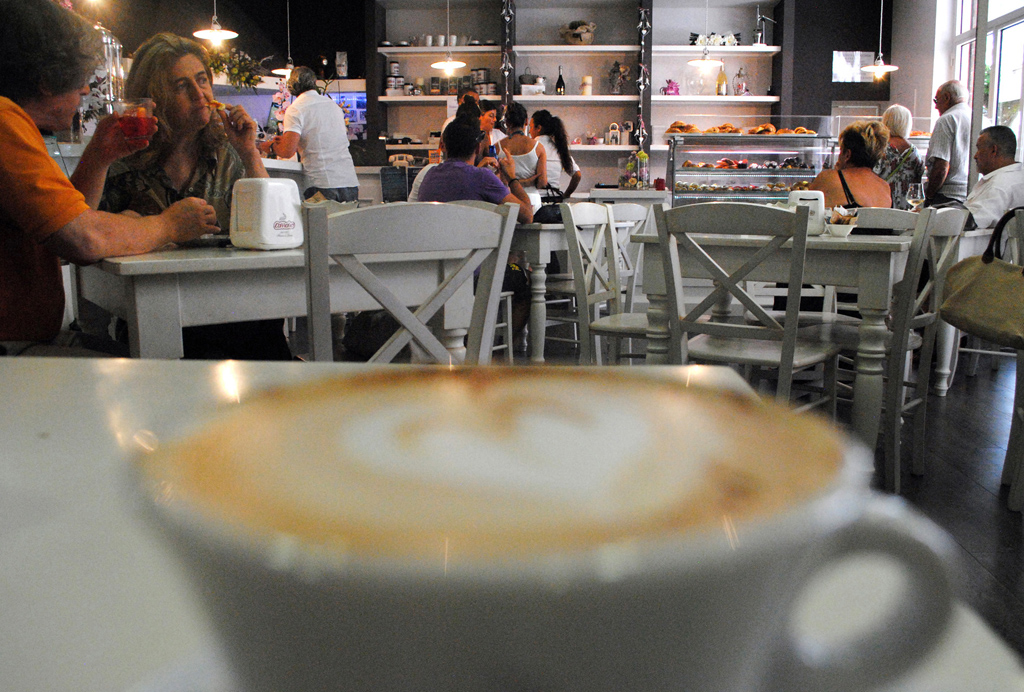by Stephen Miller.
The sun rises and its rays kiss the medieval village of Cagli. Residents awake and head to the nearest café to savor an espresso, macchiato, or cappuccino. Inside the doors of a café, the espresso machine whistles, demanding the customers’ attention. Dark, rich, creamy liquid flows from the metallic machine into the white porcelain saucer and cup below. Topped with an artistic leaf or heart, the head of foam tantalizes its patron as the barista presents the cup. Regulars stand at the counter, sipping on a traditional espresso shot before their daily agenda.
Coffee is a cornerstone in this Italian society.
Quality reigns king among coffee connoisseurs scattered among Cagli’s many cafés. “Our culture is to get a coffee…but it’s hard to find a good coffee,” says Lorenzo Luchini, the man behind the counter at Guazza restaurant and bar. Lorenzo echoes the opinion of many Cagliesi. For him, the perfect brew is a pure espresso.
The perfect espresso isn’t happenstance; it’s intentionally designed. Each phase of brewing requires knowledge, experience, and care. The selection of quality beans, the purity of the water, the temperature at which the delicacy is brewed, and finely ground beans to a precise density all play vital roles in brewing quality espresso.
There are many pleasant cafés arranged throughout the town of Cagli, each one presenting unique charm. Down the cobblestone street from the piazza resides La Bottega del Caffe’, which offers a mouth-watering piece of chocolate to complement the rich espresso. “I was born behind the counter,” chuckles Domenico Cardaciotto,
NBLa Bottega’s dedicated manager, as he reminisces about his upbringing. Nico, as he is known by his friends, belongs to a family that has bought, managed, and sold 33 cafés. Like a scientist at work in a lab, Nico measures the fineness of the grind, perfectly filters the water, and monitors the temperature to create the ideal espresso.
The common espresso becomes unique in Cagli. Its smooth bold taste awakens the flavors of the roasted beans. A macchiato holds the same flavor as espresso, but with an added slight head of milky foam to soften the hot beverage. The cappuccino, another favorite, equally blends espresso with milk and is presented with a full artisan head of foam.
While these drinks in their purest form are most prevalent, countless coffee concoctions find their home in Italy. “Three people come to the counter and there will be three unique cups of coffee,” Lorenzo reveals. Patrons at Guazza request their coffee with sugary chocolate dressing, mixed with a liquor of choice, or accompanied with a scoop of fresh gelato creating an espresso-based refreshing delight.
Piazzas are the center of life in Italian villages. Cafés in Cagli, much like a piazza, accommodate many of the townspeople’s social interaction.
Beyond the chatting and laughing in the café sits a beverage that accompanies these human interactions. Lorenzo expressed that locals come to his establishment primarily to form connections. The company, nearly as much as the brew, enhances the flavor of the hot cup. It is for this reason that the people of Cagli prefer to have their espresso at the café instead of their homes.
Following the cultural norms of the café is essential. Visitors to this classical city are surprised when an eyebrow-raising gaze darts their way when ordering a cappuccino in the afternoon. Ordering coffee with milk is simply not appropriate for the afternoon; enjoy it in the morning. This custom needs little explanation for the people of Cagli.
Café goers stand at the bar or sit around a table to engage with the community. Therefore, acts that appear disengaging, particularly working on personal laptops and mobile devices, are frowned upon. Whether the visit lasts a minute or an hour, the café and the cup of coffee are designed to enhance the present moment.
Enjoying a coffee with the local Cagliesi is like being welcomed into a family, a family that appreciates and enjoys company as much as an excellent espresso. The savory taste, the delicate process, and the relational connection felt when the warm rush of dark espresso is sipped are unmatched.












Comments